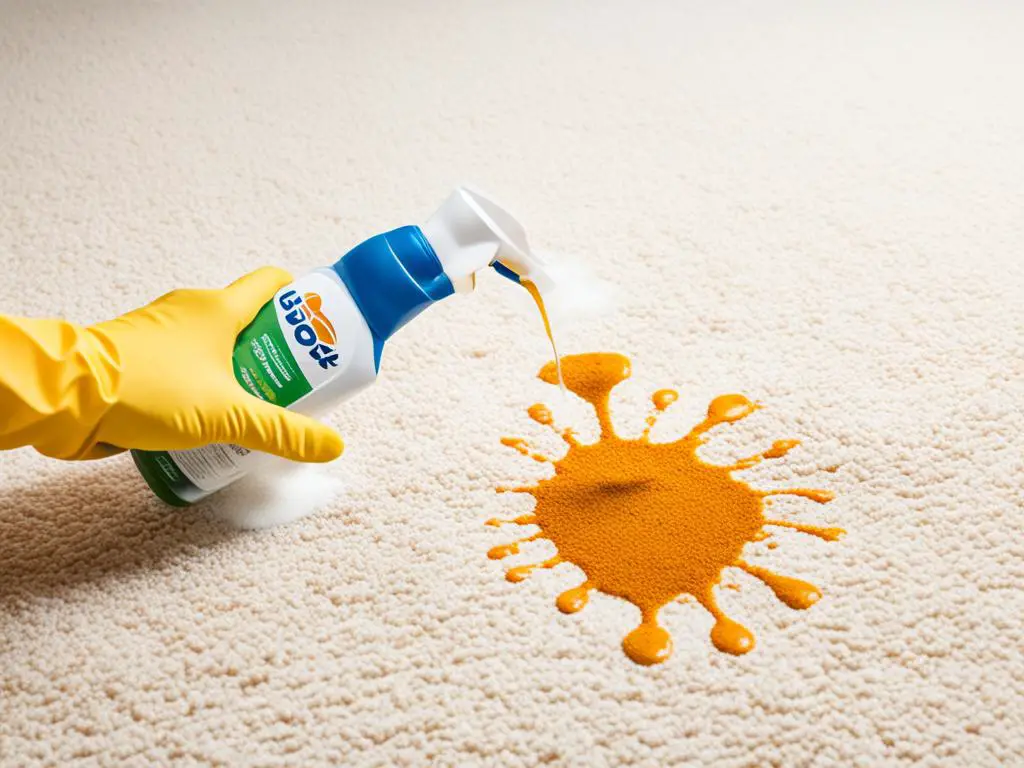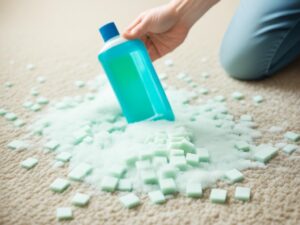Curry stains on carpets can be frustrating to deal with, but fear not! With the right techniques and a little know-how, you can easily remove those stubborn curry stains. Whether it’s a recent spill or an old stain that’s been lingering, we’ve got you covered. In this article, we’ll guide you through the process of how to get curry stains out of carpet fibers, step by step. Say goodbye to unsightly stains and hello to clean, fresh carpets!
Key Takeaways:
- Knowing how to remove curry stains from carpets is essential for effective stain removal.
- Start by scraping off any excess curry and then blot the stain with warm or sparkling water.
- Having the right tools, such as a spoon, white vinegar, and rubbing alcohol, can make the stain removal process easier.
- For tough stains, try using home remedies like baking soda, lemon juice, or glycerin.
- If all else fails, consider seeking professional cleaning services for dry-clean-only fabrics or delicate items.
How to Get Curry Stains Out of Carpets
When curry spills on your beloved carpet, it can leave behind stubborn stains. But fear not! With the right curry stain removal tips and carpet cleaning techniques, you can eliminate those unsightly marks and restore the beauty of your carpet. Follow these simple steps to get curry stains out of carpets effectively:
- Start by removing any surface-level curry using a spoon. Gently scrape off the excess curry without rubbing it into the fibers.
- Next, dampen a clean kitchen towel with warm water or sparkling water. Dab the stained area, gently pressing the towel onto the stain to absorb as much curry as possible. Avoid rubbing, as this can push the stain deeper into the carpet fibers.
- If using sparkling water, it’s a great choice for rinsing off the cleaning solutions without leaving behind residue.
- Repeat the process of dabbing and blotting with a fresh towel until you have removed as much of the curry stain as possible.
Pro Tip:
For best results, tackle the curry stain as soon as possible. The longer it sits on your carpet, the harder it may be to remove.
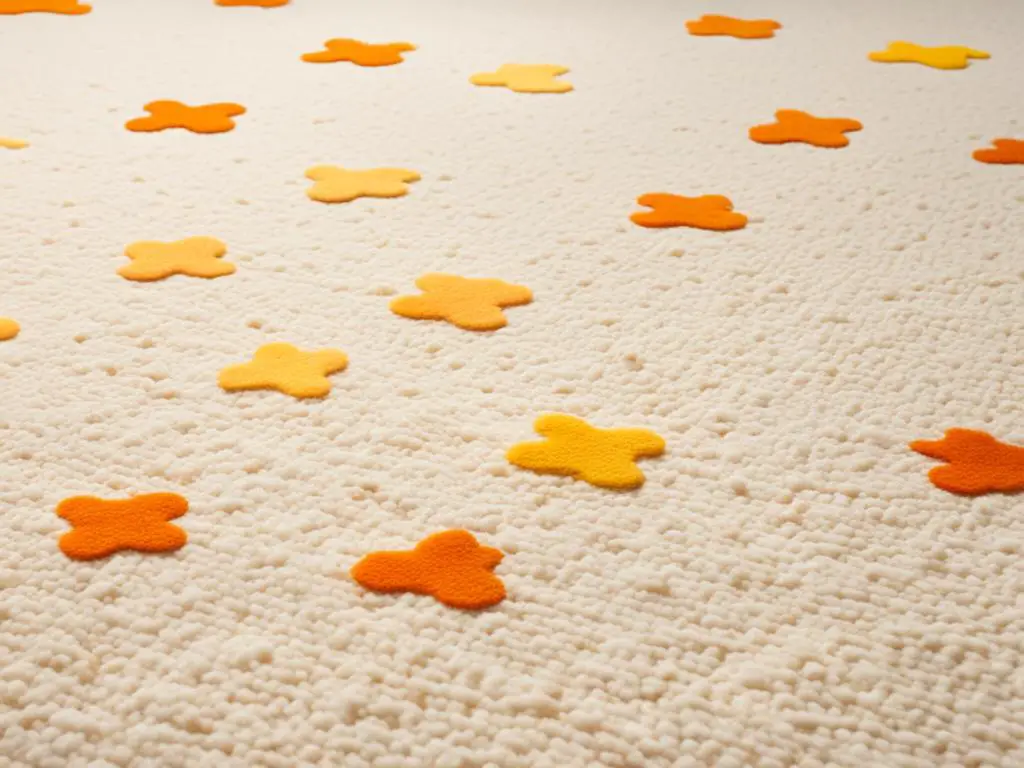
Removing curry stains from carpets doesn’t have to be a daunting task. By following these curry stain removal tips and taking immediate action, you can keep your carpets looking clean and pristine.
The Essential Kit for Curry Stain Removal
To effectively remove curry stains from carpets, it is important to have the right tools on hand. Here are some items that can be helpful in removing curry stains:
- Spoon
- Washing up liquid
- White vinegar
- Warm water
- Sparkling water
- Kitchen towel
- Rubber gloves
- Rubbing alcohol
- Ammonia
Having these items readily available can make the stain removal process easier and more efficient.
Curry Stain Removal Kit Checklist
| Item | Purpose |
|---|---|
| Spoon | To scrape off excess curry from the carpet surface. |
| Washing up liquid | To create a cleaning solution for stubborn stains. |
| White vinegar | To help break down curry stains and eliminate odors. |
| Warm water | To dilute cleaning solutions and rinse off stains. |
| Sparkling water | To rinse off cleaning solutions without leaving a residue. |
| Kitchen towel | To blot and absorb liquid from the carpet. |
| Rubber gloves | To protect your hands during the stain removal process. |
| Rubbing alcohol | To tackle tough stains and remove residue. |
| Ammonia | To help with stain removal on carpets or fabric surfaces. |
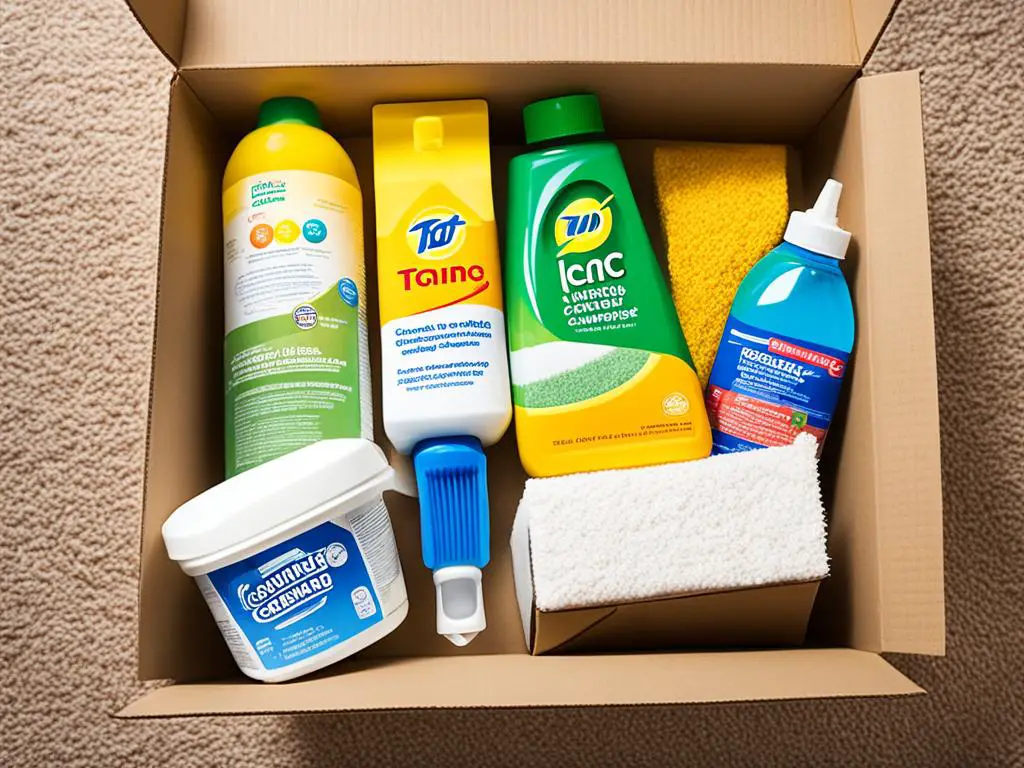
Step-by-Step Guide for Removing Curry Stains from Carpet Fibers
Once you have gathered the necessary tools, you can begin the process of removing curry stains from carpet fibers. Follow this step-by-step guide to effectively remove curry stains and restore the beauty of your carpet.
- Tidy up the surface: Start by scraping off the excess curry using a spoon or a blunt knife. Be gentle to avoid pushing the stain further into the carpet fibers.
- Dab the stain: Dip a clean cloth or sponge in warm water or sparkling water, and gently dab the stain. Avoid rubbing, as it can smear the stain and make it harder to remove.
- Blot the stain: Use a dry kitchen towel or paper towel to blot the stain. Press the towel firmly against the stain to absorb as much liquid as possible.
- Prepare a cleaning solution: If the stain persists, create a cleaning solution by mixing a teaspoon of washing up liquid and a tablespoon of white vinegar with two cups of warm water.
- Dab the stain with the solution: Dip a clean cloth or sponge into the cleaning solution and gently dab the stain. Make sure to cover the entire stained area.
- Blot and rinse: Blot the stain again with a dry kitchen towel to remove excess moisture. Rinse the area with cold water and blot dry.
- Try alternative solutions: If the stain is still visible, you can try using rubbing alcohol or a solution of washing up liquid and ammonia. Follow the same process of dabbing, blotting, rinsing, and drying.
- Air-dry the carpet: Allow the carpet to fully air-dry before walking on it or placing any furniture back in the area.
Remember, the key to successful curry stain removal is to act quickly and avoid rubbing the stain. Dabbing and blotting the stain gently will help prevent it from spreading and becoming more difficult to remove.
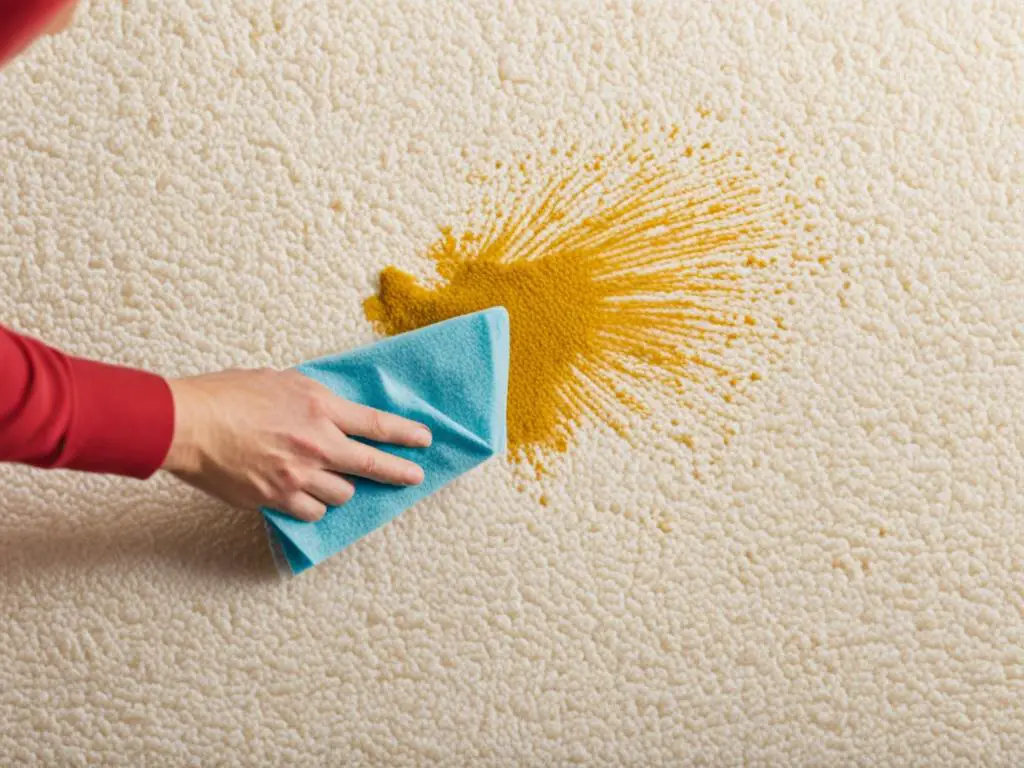
Expert Tip:
For tough curry stains, consider using a carpet stain remover specifically designed for oil-based stains. Test the cleaner on a small, inconspicuous area of the carpet before applying it to the stained area to ensure it doesn’t cause any discoloration or damage.
Removing Curry Stains from Different Types of Fabrics
The techniques for removing curry stains from carpets can also be applied to different types of fabrics. Whether you’re dealing with fabric stains or upholstery, there are effective methods to eliminate curry stains from various fabric surfaces.
For fabric stains: If you have a curry stain on fabric, such as clothing or bedsheets, you can try using glycerine to remove it. Simply apply a small amount of glycerine to the stain and rub it gently. Then, rinse the fabric with cool water before laundering it as usual. This method can help lift the stain and ensure a clean, fresh appearance for your fabrics.
For upholstery: If you encounter a curry stain on your upholstery, such as a couch or chair, a mixture of liquid hand dishwashing detergent and white vinegar can work wonders. Start by mixing these two ingredients with cool water. Then, sponge the stain with the solution, making sure to blot it with a clean cloth to absorb the curry and cleaning solution. Lastly, rinse the area with cool water to remove any remaining residue. Your upholstery will thank you for this effective stain removal method.
These methods are simple yet effective in tackling curry stains on different types of fabrics. By following these techniques, you can ensure that your fabrics remain stain-free and looking their best.
Now, let’s dive deeper into the specifics with a helpful table that outlines different fabric types and the corresponding curry stain removal methods:
| Fabric Type | Curry Stain Removal Method |
|---|---|
| Cotton | Gently rub glycerine into the stain and rinse with cool water before laundering. |
| Wool | Apply a mixture of liquid hand dishwashing detergent and white vinegar with cool water. Sponge the stain, blot with a clean cloth, and rinse with cool water. |
| Synthetic (Polyester, Nylon, etc.) | Rub glycerine into the stain and rinse with cool water before laundering. |
| Silk | Use a mixture of liquid hand dishwashing detergent and white vinegar with cool water. Sponge the stain, blot with a clean cloth, and rinse with cool water. |
| Leather | Use a commercial leather cleaner or consult a professional for stain removal. |
By following these fabric-specific stain removal methods, you can effectively remove curry stains from a wide range of fabrics. It’s important to treat each fabric type with care and use the appropriate cleaning techniques to prevent any damage.
Additional Tips and Home Remedies for Curry Stain Removal
In addition to the previously mentioned techniques, there are some home remedies that can be effective in removing curry stains. These remedies are often easily accessible and can provide excellent results. Let’s explore some of them:
1. Baking Soda for Stain Removal
Baking soda is a versatile household ingredient that can help tackle the oil component of curry stains. Its absorbent properties make it effective in lifting the stain from fabrics. Here’s how to use baking soda to remove curry stains:
- Blot the stain with a dry cloth or paper towel to remove any excess curry.
- Sprinkle a generous amount of baking soda directly onto the stain.
- Gently rub the baking soda into the stain using a soft brush or your fingers.
- Leave the baking soda on the stain for about 30 minutes to allow it to absorb the oils.
- Vacuum or brush off the baking soda.
2. Lemon Juice for Stain Removal
Lemon juice is another effective home remedy for curry stain removal, especially on white fabrics. Its natural bleaching properties can help lighten the stain. Follow these steps to use lemon juice for stain removal:
- Blot the stain with a dry cloth or paper towel.
- Squeeze fresh lemon juice directly onto the stain.
- Gently rub the juice into the stain using a cloth or sponge.
- Allow the lemon juice to sit on the stain for a few minutes.
- Rinse the fabric with cool water to remove the lemon juice.
- Repeat the process if necessary.
3. Other Home Remedies
Aside from baking soda and lemon juice, there are a few other home remedies that can be useful in removing curry stains:
- Mixing vinegar and baking soda to form a paste can help treat tough and greasy stains.
- Glycerin can be applied directly to the stain and rinsed with water before laundering.
- Plain white toothpaste can be used to gently scrub the stain before rinsing with water.
It’s important to note that different fabrics may require specific care instructions and varying amounts of these remedies. Always refer to the specific instructions provided for each method to ensure effective stain removal without causing any damage to the fabric.
Using these home remedies can be an affordable and convenient way to remove curry stains from your carpets or fabrics. However, for tough stains or delicate fabrics, it’s always advisable to consult a professional cleaner to avoid any potential damage.
Professional Cleaning and Tips for Delicate Fabrics
If the curry stain persists after trying various stain removal methods, it may be necessary to seek professional cleaning services. Professionals have access to specialized cleaning chemicals that can effectively remove tough stains. This is especially important for dry-clean-only fabrics, delicate fabrics, or vintage items that require specific handling techniques. It’s best to consult a professional cleaner for these types of fabrics to avoid any potential damage.
Expert Stain Removal Services
When it comes to stubborn curry stains on delicate fabrics or dry-clean-only items, professional stain removal services offer the expertise needed for effective cleaning. These professionals have the knowledge and experience to handle different fabric types and remove tough stains while minimizing the risk of damage. By utilizing professional cleaning services, you can ensure that your delicate fabrics are treated with the utmost care and the stains are effectively removed.
Tips for Delicate Fabric Stain Removal
For delicate fabrics such as silk, satin, or lace, extra caution is required during stain removal. Here are some tips to keep in mind:
- Spot Test: Before using any cleaning solution, always spot test it on a discreet area of the fabric to ensure there is no adverse reaction.
- Gentle Dabbing: Instead of rubbing the stain, gently dab it with a clean cloth or sponge to avoid spreading the stain or causing damage to the fabric fibers.
- Use Mild Detergents: Opt for mild detergents specifically formulated for delicate fabrics. Avoid using harsh chemicals or bleach, as they can cause discoloration or damage.
- Follow Care Instructions: Always refer to the care label on the fabric for any specific instructions or restrictions regarding stain removal.
- Professional Assistance: If you’re uncertain about treating a delicate fabric stain yourself, it’s best to consult a professional cleaner who specializes in handling delicate fabrics.
Pros and Cons of Professional Cleaning vs. DIY Stain Removal
| Professional Cleaning | DIY Stain Removal |
|---|---|
| Specialized cleaning chemicals for tough stains | Limited to household cleaning products |
| Knowledge and expertise in handling delicate fabrics | Requires research and experimentation |
| Reduced risk of damage to fabrics | Potential for fabric discoloration or damage if done incorrectly |
| Convenient and time-saving | Requires time and effort for stain removal |
| Professional assessment of persistent stains | May struggle with stubborn or set-in stains |
Conclusion
Removing curry stains from carpets can be a breeze if you have the right techniques and tools at your disposal. By following the step-by-step guide and using home remedies, you can effectively eliminate curry stains from various fabric surfaces. It’s crucial to act quickly and choose the appropriate cleaning solutions based on the type of fabric you are dealing with.
If all your efforts fail, don’t panic! Professional cleaning services are available to tackle tough or delicate stains that resist typical removal methods. They have access to specialized cleaning chemicals and techniques that can restore your carpets to their former pristine condition.
With the tips and tricks provided in this article, you can confidently bid farewell to unwanted curry stains and keep your carpets looking clean and stain-free. Whether you opt for DIY stain removal or seek professional help, remember to approach the process with patience and care. By doing so, your carpets can remain a beautiful and inviting part of your home.
